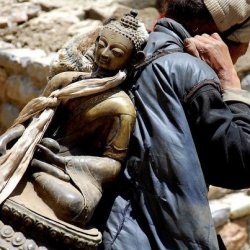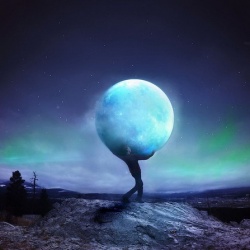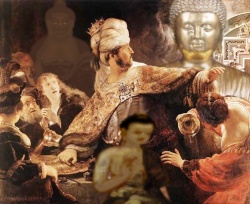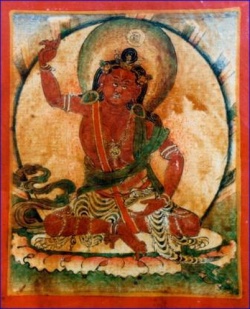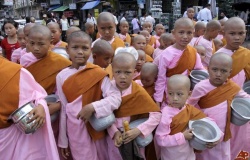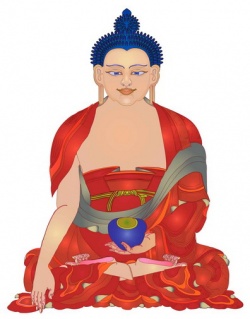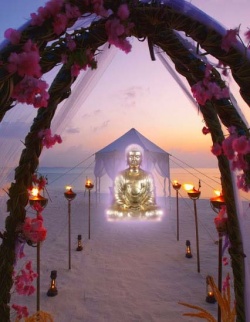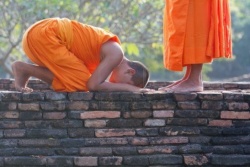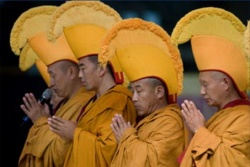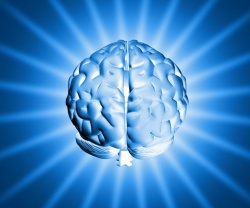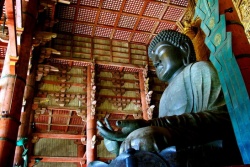Supramundane Jhanas
Joel Rosenblum
April 11
Another silly question: Where are the supramundane jhanas described? If one experiences that there is no difference between the sense of the body and the scenery, that all is one whole blissful experience, is that a supramundane jhana? What if it happens in a dream state? Would it then be a jhana?
LikeLike ·
Wei Yu http://books.google.com.au/books?id=iEyJpmZSMHkC&pg=PT130...
Bhante Gunaratana: "You attain supramundane jhanas at the moment of stream entry."
Hence supramundane jhanas are not merely a state or experience of bliss, etc, (which are classified as mundane jhana) as far as I understand.
Beyond Mindfulness in Plain English
books.google.com.au
Every meditation tradition explains that there are two aspects to any effective ... See More
April 12 at 6:04pm · Edited · Like · 1 · Remove Preview
David Vardy The supramundane jhanas appear to be irreversible characterized by the absence of doubt.
April 12 at 7:13pm · Like · 1
Joel Rosenblum Looks like no one has had these supramundane jhanas that all stream entered are supposed to have. No one remembers them anyway...
April 12 at 10:38pm · Like
Joel Rosenblum Is the experience of anatta related to what i described, Wei Yu? It seems to me more than just no self... Which to me could be experienced in many ways...
April 12 at 10:40pm · Like
Wei Yu When anatta is realized and actualized, there is no sense of a body, only disjoint and self-luminous/self-felt sensations without sensor, and sceneries are just self-seen/self-felt where they are without a seer and thus without distance or gap. Everything is self-luminous and blissful.
However, all these can be experienced as mere non-dual experience without insight into anatta. Insight is the key that makes non-dual luminosity effortless, natural, etc and free from any kind of subjectification (like into 'one Self'), as there is a quantum shift of perception and thus one stops fabricating any sense of a subjective essence, agent, knower, doer, etc behind gapless self-luminous experience.
April 12 at 11:39pm · Edited · Like · 1
Wei Yu Anatta is a dharma seal and realization of anatta must arise (not just experience), otherwise it is just mere peak experiences of non-dual, there is no fundamental transformation.
April 12 at 11:26pm · Edited · Like · 1
David Vardy ....which is 'irreversible'.
April 13 at 2:22am · Unlike · 1
Justin Chapweske It was a shock for me when I was able to access Jhana 5-8. After a while I don't even notice any more because most of those mind states have lost their novelty. The only one I really notice occasionally is Neither-Perception-Nor-Non-Perception just because it is fairly weird. I sometimes notice that one at the edges of sleep.
April 13 at 2:00pm · Like
Justin Chapweske This video is a nice way to check in with your jhanas and get some perspective on how a couple of others are seeing them - https://www.youtube.com/watch?v=PRdiOoTZC3A
Play Video
Guided Tour to 13 Jhanas (Part 1)
Meditation teacher Kenneth Folk and dharma explorer Nick Halay team up for a gui... See More
April 13 at 2:00pm · Like · 1 · Remove Preview
Justin Chapweske Kenneth personally led me through the first 4 for the first time and I couldn't stop laughing for almost 4 hours afterwords. It definitely makes you appreciate how dynamic and vast the mind is in its capabilities.
April 13 at 2:02pm · Like
Joel Rosenblum The Jhanas 4-8 you speak of are the mundane formless ones. I'm speaking of the supramundane ones which no one seems to have a clue about.
April 13 at 2:22pm · Like
Justin Chapweske Ah interesting - I guess I hadn't heard of path moments themselves being called jhanas.
April 13 at 3:04pm · Like
Justin Chapweske Do you access these states as absorptions or just momentary experiences?
April 13 at 3:04pm · Like
Justin Chapweske Anyway, if you're looking for other information, the sources that I'm most familiar with would call these path moments and fruition.
April 13 at 3:06pm · Like
Wei Yu supramundane jhana is a term coined in visudhimagga I believe, also, bhante gunaratana seems to define it as the attainment of fruition as well as nirodha samapatti: http://books.google.com.au/books?id=60XGopCAzwgC&pg=PA214...
The Path of Serenity and Insight
books.google.com.au
In the oldest scriptures of Theravada Buddhism much attention is given to the jh... See More
April 13 at 3:12pm · Like · Remove Preview
Wei Yu In Daniel Ingram's MCTB fruition is defined as a blackout of consciousness state and amazing afterglow. Im not sure if this is the same in the commentaries. But Daniel sees that fruition as only essential for the lower paths as on his version of third and fourth path the essential point is to look beyond/outside fruitions to something more immediate, real-time, luminosity and centerlessness of experience, culminating in what I call realization of anatta in MCTB 4th path. However all these descriptions of fruitions etc does not necessarily reflect the suttic description of paths, etc.
April 13 at 3:19pm · Edited · Like
Justin Chapweske Woah. That is a lot of discongruity. Mahasi Sayadaw's Progress of Insight definitely does not refer to attainment of fruition as nirodha samapatti.
April 13 at 3:26pm · Like
Justin Chapweske If we're talking about path moments, I like David Vardy 's description.
April 13 at 3:31pm · Like
Wei Yu Well, Daniel does not define fruition as nirodha samapatti, but both states are similar as a form of 'blackout' 'gap' (in the MCTB definition of it - I'm not sure if Mahasi Sayadaw tradition defines it in the same way).
Daniel M. Ingram:
"Dear VIV,
I have been working a whole lot lately and so got a little behind on my DhO reading.
Sorry I am just getting to this now.
A few things:
Fruitions are a complete and utter gap without anything going on at all and not even that. Reality, every single bit of it, including space, awareness, "primordial" anything, consciousness, perception, perspective, time, timelessness, unity, nothingness, somethingness and anything else: all completely and utterly gone, such that nothing is there to mark the gap except the entrance and exit and the fact of a complete resetting of the mind and an utterly atemporal, aspacial gap. Do not settle for any muted definition or wiggle on this one: it won't help.
NS is quite an attainment. It does really change things and is important. It is only accomplished by anagamis and arahats who have access to the formless realms. As stated, the setup is specific to it, sort of like the easter-egg functionality in a game like Mario Brothers, in which, say, one jumps on the golden mushroom on level 5 three times, the green egg appears, and you use this to open the secret magic crystal once you cross the bridge. In exactly that way, an anagami or an arahat sets up the entrance by rising to 8th, coming out and resolving and then, if one is good or lucky, it happening. It is complete in the way Fruitions are, but its entrance and exit are different, and the afterglow is a whole different world of afterglow from anything else. Criteria again should be strictly applied: not anagami or arahat, not it, not set up in the proper way, not it, anything happening during it, not it, entrance and exit not in the specific order or mode of NS, not it, afterglow not really profound and long-lasting, not it.
The A&P in all its variants and complexities is a pernicious mimic and this should be watched for with care.
As to which path, I don't see anything that specifically talks about the information or criteria that apply to that sort of thing, such as progression of the paths, insight cycles, progression of various walking-around perspectives, ability to perceive certain aspects of things.
Helpful?
Daniel "
April 13 at 5:47pm · Edited · Like
Wei Yu Personally I see stream entry as the realization of anatta, directly penetrating the emptiness of inherent subject/essence/agent in/apart from dharmas/units of experience. Daniel seems to see it as arahantship/4th path
April 13 at 8:56pm · Like · 1
Jon Norris The Four Jhanas
“Furthermore, quite withdrawn from sensuality, withdrawn from unskillful mental qualities, he enters and remains in the first jhana: rapture and pleasure born from withdrawal, accompanied by directed thought and evaluation. He permeates and pervades, suffuses and fills this very body with the rapture and pleasure born from withdrawal.”
“And furthermore, with the stilling of directed thoughts and evaluations, he enters and remains in the second jhana: rapture and pleasure born of composure, unification of awareness free from directed thought and evaluation — internal assurance.”
“And furthermore, with the fading of rapture, he remains equanimous, mindful, and alert, and senses pleasure with the body. He enters and remains in the third jhana, of which the Noble Ones declare, 'Equanimous and mindful, he has a pleasant abiding’.”
“And furthermore, with the abandoning of pleasure and pain — as with the earlier disappearance of elation and distress — he enters and remains in the fourth jhana: purity of equanimity and mindfulness, neither-pleasure-nor-pain. There is nothing of his entire body un-pervaded by pure, bright awareness.”
Kayagata-sati Sutta: Mindfulness Immersed in the Body
translated from the Pali by
Thanissaro Bhikkhu © 1997
____
As with the nyams in Vajrayana, I wouldn't labor over the jhanas. They are all transitory meditative states whose only significance to the path is that you need to take care that you don't become attached to them. They can dead end progress for an entire lifetime, so you treat them just as you would any other dualistic phenomena. In other words, spontaneously liberate them as they arise.
April 13 at 9:44pm · Like
Wei Yu In the Pali Suttas teachings of Buddha , the four jhanas are classified under the 'Right Samadhi' portion of the noble eightfold path, and thus are seen as essential practice for full liberation (there are interpretations as to whether one could ever attain full liberation without any jhanas in Theravada, but regardless it is seen to be quite important).
I thought Vajrayana didn't care less about jhanas, but interestingly, recently Malcolm (Loppon Namdrol) wrote:
Rongzom makes the point very clearly that Dzogchen practitioners must develop the mental factors that characterize the first dhyana, vitarka, vicara, pritvi, sukha and ekagraha, i.e. applied attention, sustained attention, physical ease, mental ease and one-pointedness. If you do not have a stable samatha practice, you can't really call yourself a Dzogchen practitioner at all. At best, you can call yourself someone who would like to be a Dzogchen practitioner a ma rdzogs chen pa. People who think that Dzogchen frees one from the need to meditate seriously are seriously deluded. The sgra thal 'gyur clearly says:
The faults of not meditating are:
the characteristics of samsara appear to one,
there is self and other, object and consciousness,
the view is verbal,
the field is perceptual,
one is bound by afflictions,
also one throws away the path of the buddhahood,
one does not understand the nature of the result,
a basis for the sameness of all phenomena does not exist,
one's vidya is bound by the three realms,
and one will fall into conceptuality
He also added:
Dhyanas are defined by the presence or absence of specific mental factors.
The Dhyanas were not the vehicle of Buddha's awakening, rather he coursed through them in order to remove traces of rebirth associated with the form and formless realms associated with the dhyanas.
April 13 at 9:52pm · Edited · Like
Wei Yu Also older posts by him:
Whether you are following Dzogchen or Mahamudra, and regardless of your intellectual understanding, your meditation should have, at base, the following characteristics:
Prthvi -- physical ease Sukha -- mental joy Ekagraha -- one-pointedness Vitarka -- initial engagement Vicara -- sustained engagement
If any of these is missing, you have not even achieved perfect samatha regardless of whether or not you are using an external object, the breath or even the nature of the mind.
...
Even in Dzogchen, the five mental factors I mentioned are key without which you are really not going to make any progress.
April 13 at 9:54pm · Like · 1
Jon Norris Wei Yu, I couldn't agree more Malcolm and Rongzom. Thanks for that post - it's absolutely brilliant. So many folks think they can skip shamatha these days, but when they do they are throwing away this precious human life in order to cling to the concept of 'a pathless path'. It's like mental cocaine - they want to skip all that boring mindfulness stuff and zone-out on 'being'. What they don't see is that shamatha is the only way to precipitate out the past karma and attain a state in which latent karma creates no further attachment. Hence, they are walling themselves off from the one thing that might have ended the cycle of samsara. The current trendy focus on Dzogchen without a foundation of shamatha is really doing harm to Buddhism, but (just like cocaine) it seems to be addictive to the ego, especially in the west.
April 13 at 10:12pm · Unlike · 2
Justin Chapweske For me, the first three fetters dropped when doing vipassana and I momentarily glimpsed / objectified a phenomena that I previously took to be the sense of self. The afterglow was intense, probably an almost non-dual experience but my view did not yet realize how phenomena were self-luminous. The first three fetters clearly dropped at that point.
April 14 at 1:54am · Like
Justin Chapweske It wasn't until maybe two years later while doing vipassana/shamata with "awareness" as my object of concentration that "awareness" fully dropped away and the Bahiya sutta became strikingly clear and it became obvious that experience is always already this way, regardless of mind state. This is what, in your writing, Soh, that you seem to equate with the anatta stage. This happened for me sometime after dropping of the first 3 fetters, so I would not map that to stream entry based on my personal path.
April 14 at 1:58am · Like
David Vardy It's possible and quite common to experience the headless state, I AM, experiencing the absence of separation after discovering that the subject is in effect the absence of its object. Inside/outside, above/below, etc all deconstructed but still present is the subject/object relationship. Only anatta, the total collapse of subject per say, demonstrates the fiction of that relationship. In other words, It is the end of relationship while the presence of relationship is understood to be purely fictional. Ironically, it's the beginning of sharing in the true sense, because what's being passed on are the tools for deconstructing what has till now been thought of as real, dualistically speaking.
April 14 at 2:58am · Like · 1
Justin Chapweske I'm going to throw out this idea:
1) we can objectify the subject. Once the subject is seen as object, it cannot be subject.
2) we can subjectify the objects. All objects can become subject which gives the feeling of unity.
3) we can experience subject disappear as all objects disappear in a moment of cessation
4) we can experience that subject is none-other than object as it becomes clear that objects are luminous and self known.
All four of these should generate some insight.
From the perspective of either #1 or #2, the opposite doesn't really make sense.
From the perspective of #4 though, all previous constructions make sense.
April 14 at 3:16am · Like
Wei Yu Justin Chapweske the end of self view includes the end of taking any sort of Awareness/Consciousness as being a true self or witness or metaphysical essence of any sort, otherwise it is merely dissociating from some phenomena into an object in order to identify with another ultimate Subject or Self. It is still same old self view except expanded into something seemingly more ultimate called Awareness and sotapanna puts an end to any such possibility of identifying oneself as anything including presence/awareness etc. Instead via realization of anatta one sees everything including presence as mere self less aggregates. Was that what you called stream entry? Does your so called stream entry still enable the possibility of shifting self view from apparent egoic self to some transcendental Self as awareness?
April 14 at 3:37am · Edited · Like
Justin Chapweske When the first three fetters dropped for me, I still definitely identified with Awareness as Self. I'm not one to define what sotapanna is or is not, but if you define sotapanna as the elimination of the first three fetters and possibly also access to the formless jhanas, then my experience is that stream entry happened for me way before bahiya sutta realization.
April 14 at 3:45am · Like
Wei Yu Then we understand 'self view' differently. In accordance with the suttas, 'self view' includes:
Sabbasava Sutta: "...As he attends inappropriately in this way, one of six kinds of view arises in him: The view I have a self arises in him as true & established, or the view I have no self... or the view It is precisely by means of self that I perceive self... or the view It is precisely by means of self that I perceive not-self... or the view It is precisely by means of not-self that I perceive self arises in him as true & established, or else he has a view like this: This very self of mine — the knower that is sensitive here & there to the ripening of good & bad actions — is the self of mine that is constant, everlasting, eternal, not subject to change, and will stay just as it is for eternity. This is called a thicket of views, a wilderness of views, a contortion of views, a writhing of views, a fetter of views. Bound by a fetter of views, the uninstructed run-of-the-mill person is not freed from birth, aging, & death, from sorrow, lamentation, pain, distress, & despair. He is not freed, I tell you, from suffering & stress."
- http://awakeningtoreality.blogspot.com.au/2011/10/anatta-not-self-or-no-self.html
Identifying Awareness as Self definitely classifies as 'self view', and hence, holders of such view cannot be considered stream enterers in accordance with the sutta's definition.
Stream enterers cannot possibly identify any kind of self/Self and instead sees everything as merely self-less conditioned aggregates.
Awakening to Reality: Anatta: Not-Self or No-Self?
awakeningtoreality.blogspot.com
robertk:This is an old post from ven. Dhammanando that i likedhttp://www.lioncit... See More
April 14 at 3:55am · Edited · Like · Remove Preview
Wei Yu Any kind of view of a self/Self in OR apart from the aggregates, are all the fetter of self view.
Udana Sutta: "Now, a well-instructed disciple of the noble ones — who has regard for nobles ones, is well-versed & disciplined in their Dhamma; who has regard for men of integrity, is well-versed & disciplined in their Dhamma — does not assume form to be the self, or the self as possessing form, or form as in the self, or the self as in form. He does not assume feeling to be the self... does not assume perception to be the self ... does not assume fabrications to be the self... He does not assume consciousness to be the self, or the self as possessing consciousness, or consciousness as in the self, or the self as in consciousness.", "He discerns, as it actually is, not-self form as 'not-self form' ... not-self feeling as 'not-self feeling' ... not-self perception as 'not-self perception' ... not-self fabrications as 'not-self fabrications' ... not-self consciousness as 'not-self consciousness."
April 14 at 3:58am · Edited · Like · 3
David Vardy So complete is 'what's happening', there isn't the space for the question concerning a self to arise. The end of doubt isn't self sustained. It's seeing the absence of anyone to be in doubt.
April 14 at 4:09am · Like · 1
Justin Chapweske What you're saying so seems logically sound. It also seems that Bhikkhu Bodhi believes that people can have the formless attainments prior to stream entry. http://www.budsas.org/ebud/ebdha267.htm
In any case, its all just words and models made up by human beings. FWIW, I like your model (7 stages of enlightenment) the best.
The Jhanas and the Lay Disciple According to the Pali Suttas
www.budsas.org
The Pali Nikayas leave no doubt of the important role the jhanas play in the str... See More
April 14 at 4:14am · Edited · Like · Remove Preview
Wei Yu Oh yes certainly non-stream enterers can attain formless attainments. All these are mundane attainments in and of themselves and do not need to be linked with awakening. Buddha's had two Hindu teachers (who were not aryans) before his awakening - one led him to the formless jhana of nothingness, the other the neither perception nor non-perception. Unsatisfied, knowing that whatever he learnt was unable to lead him to awakening or end of suffering, he left those teachers and sought for his liberation.
April 14 at 4:18am · Edited · Like · 3
John 'Genryu' "Buddha's had two Hindu teachers (who were not aryans) before his awakening..." Kind of hard for that to happen since Hinduism didn't exist at the time of the Buddha. As for the not Aryans remark, you might want to clarify what you mean by that.
April 16 at 4:07pm · Like
Wei Yu John Genryu: yes strictly speaking, they were not 'Hindu' teachers since 'Hindu' as a name came thousand years later. However, they were Samkhya teachers, who were later (thousand years later) included within the umbrella of 'Hinduism', as one of the six schools of 'Hindu' philosophy.
Not aryans = not awakened in Buddhist sense (e.g. stream entrant to arahant).
April 16 at 4:16pm · Edited · Like · 2
Justin Struble By supra-mundane jhanas, are we asking about the pureland or suddhavasa jhanas? that is what i would refer to as supra-mundane jhanas. i think anyone including daniel are wrong about fruition / nirodha / nirodha samapatti when they compare it to the cessation as a gap.
nirodha samapatti is clearly described otherwise by the buddha in the pali suttas in a way that refutes it as a gap sort of cessation. instead the buddha asserts that with attainment of nirodha samapatti there is an aware discernment, it is a realization / wisdom / discernment type of attainment in my interpretation of the pali suttas (and my own experience).
as far as the pureland or suddhavasa jhanas i have access to and experience those and i am willing to discuss them but the guided tour of the jhanas covers them decently, some more details in the mouseover of this as well:
http://rdlabs.org/~tsunami/files/pix/20.Major.Strata.of.Mind.KFD.swf
April 16 at 4:45pm · Like
Stuffs RedTurtle You ask great questions Joel!

